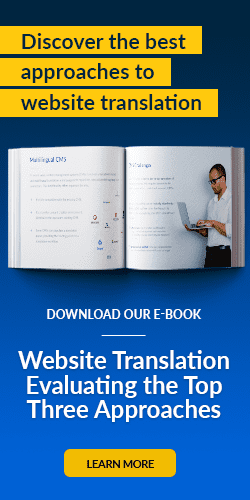To succeed in today's ever-competitive marketplace, most businesses are expanding into global markets. But to win in those frontiers, they need translated websites that literally speak their new customers' languages.
Website translation delivers big benefits, like increased customer trust, accessibility and a better overall user experience. In fact, it’s naïve to think website translation is a “nice to have.” At least 75% percent of global customers prefer to do business in their native language.
You can tackle website translation in two primary ways—with translations provided by humans, or with software (aka machine translation). Both have advantages and disadvantages. Ultimately, your choice should be informed by which one will best enable you to:
- Increase brand awareness
- Provide a consistent experience across territories
- Win more business
Website translation is no longer a “nice to have.” 75% of global customers want to conduct business in their preferred language.
The Machine Translation Option
Machine translation solutions from companies like Google and Bing have come a long way in the past five years. And breakthroughs in neural machine translation have made machine translation an increasingly viable option for some businesses.
There are certainly advantages to translating your website with machine translation, including:
- Cost: This process is often monetarily inexpensive
- Speed: These systems can translate hundreds of webpages in very little time
The disadvantages, however, quickly pile up when you examine how machine translation still doesn’t come close to how human beings actually speak to each other:
- Simplistic word choice: For grammar and vocabulary, machine translation often defaults to the lowest common denominator, stripping away nuance and details from the original content
- Lack of context: Your carefully-crafted content won’t survive, resulting in a translation that may get the basics right but provides none of the flavor
- Off-brand messaging: Machines won’t recognize how you’ve chosen certain words for their brand power, substituting a generic word and taking you off-message
- Hidden costs: Reviewing and revising these subpar translations requires unexpected time, effort and resources
Machine translation is fast and affordable, but falls short for brands that demand linguistic accuracy and authenticity.
The Human Translation Option
Out of the gate, the advantages of human translation address most of the cons of the machine approach:
- Transcending translation: Human translation isn’t just about the words—it’s about using critical thinking and cultural awareness to convey messages that resonate with each market’s audience
- Brand tone: Human translation is currently the only way to convey the “voice” of your brand by accounting for nuances in language that machines can’t catch
- Conveys creativity: Your company’s carefully-crafted turns of phrase can be shared more fully, since they’re translated by humans who understand language and culture
- ‘Brand-perfect’ translations: Again, this isn’t about word-for-word translations—it’s about capturing the spirit of the copy and brand message. That’s best understood and adapted by a human who’s fluent in the brand’s positioning
- SEO benefits: Human translators are adept at selecting the best-possible translated phrases for international SEO. For now, machine translation can’t do this.
Historically, the primary con of human translation has been the cost. But powerful turn-key solutions now exist that can leverage technologies, processes and unique expertise to eliminate much of the cost often associated with website translation. More on this in a moment.
Human translation reflects cultural awareness, and delivers messaging that resonates with local customers.
The Hybrid Option
Another way to address website translation costs is by combining both approaches. An ideal hybrid approach uses human translation for high-trafficked pages where nuance, messaging and context are crucial. Machine translation can then be used for less brand-sensitive content such as product pages, where word choice is not as important.
Conclusion
As you explore website translation solutions, look for a partner that can help you achieve success through a translation process that is, ideally, invisible to the reader.
That means finding a technology and turn-key solution that’s as nimble and flexible as your needs. These solutions can provide world-class human and machine translation options for your multilingual websites, and accommodate unique requests—such as using the hybrid approach on specific webpages, or within specific sections of webpages—to deliver superior results while controlling costs.
These smart solutions use industry-leading technologies and processes to nearly eliminate cost as a decision making factor. By combining the efficiency of technologies (found in machine translation and powerful translation management tools) and the brilliance of human translators, your website translation projects can be completed within incredibly tight deadlines, while ensuring world class, brand-perfect translations.
Last updated on July 29, 2020